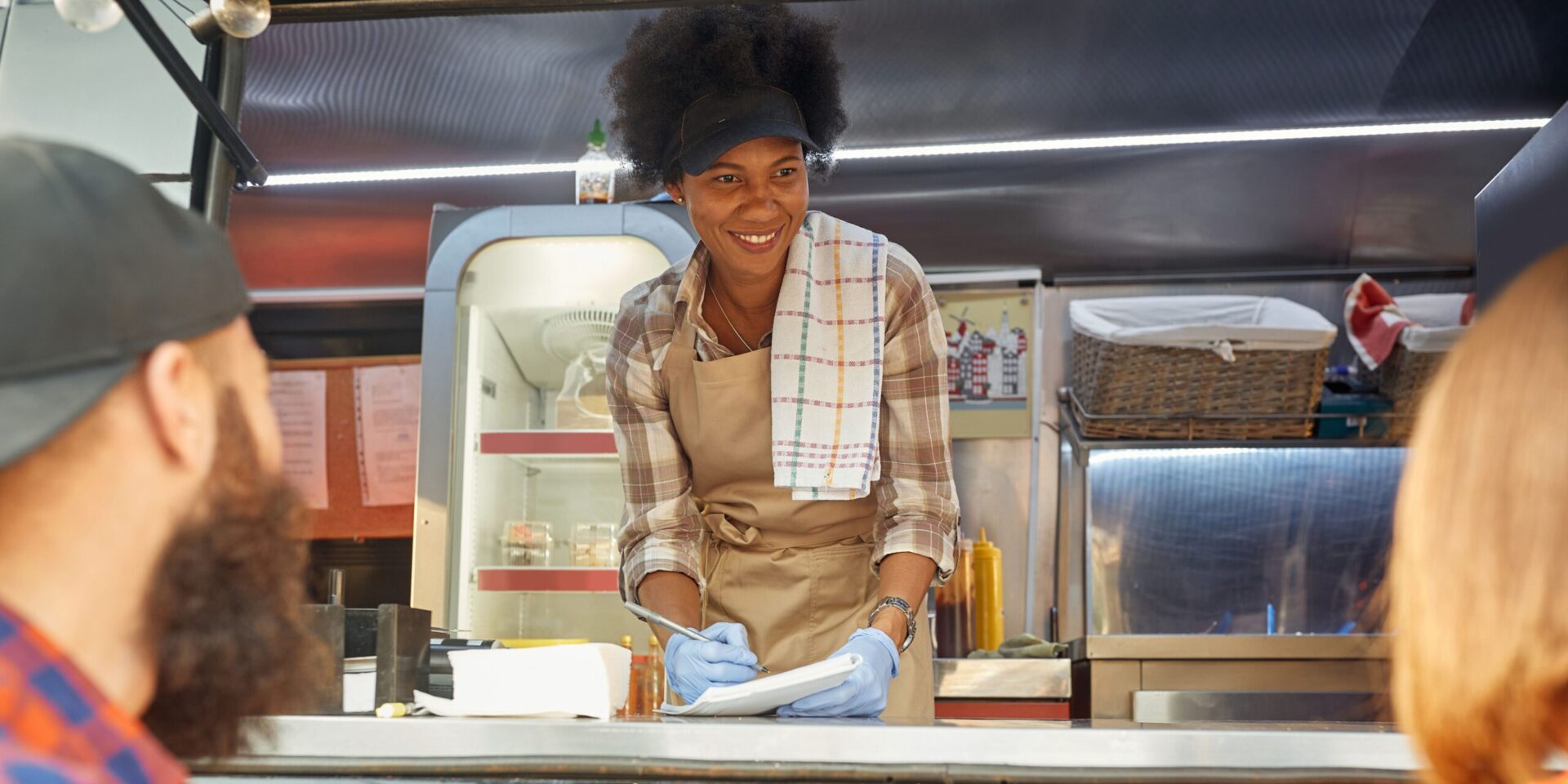
If you’re a home chef, work in a kitchen or you’ve been inspired by the latest episode of Next Level Chef, you likely know the food and beverage industry can be exciting and lucrative. However, to start a food business, there are many things to consider and legal standards to follow.
Whether it’s tax implications, business structure, or attaining proper documents, it can be discouraging to pursue a passion when there’s so much going on aside from cooking.
If you want to know more, read on to learn everything you need to know in this step-by-step guide to starting your food business.
Why Start a Food Business
To offer you insight on starting a food business, let’s begin with some of the main reasons why someone would want to start a food business:
- Passion: If you have a love for cooking and creating new recipes, starting a food business allows you to turn your passion into a career.
- Flexibility: Depending on your availability and goals, you can choose to start a food business as a part-time or full-time venture.
- Profitability: Food is a basic necessity, which means there is always a demand for it. With the right strategy and execution, a food business can generate significant income.
- Creativity: Starting a food business allows you to showcase your creativity and experiment with new flavors and cuisines.
These are just a few reasons to start a food business. If you’re a chef or a lover of food, you know how deep this craft can go.
Types of Food Business
Now that you know what to consider when it comes to starting a food business, let’s explore the different types of food businesses you can choose from.
Restaurants or Diners
Restaurants or diners are considered a brick-and-mortar type of business in which the business’s success relies on a physical location and the traffic it attracts.
Starting a restaurant or diner can be a costly investment but also the most rewarding because it creates a sense of community — encouraging locals, tourists, and repeat customers alike.
Also, If you’re the type of person who likes to be hands-on with their work and enjoys being in a physical location, then starting this kind of food business is for you.
Food Truck
A food truck is a mobile kitchen that serves food to customers on the street or at events. Food trucks have become increasingly popular in recent years, offering a unique dining experience that combines convenience and quality food.
Starting a food truck is great for those who wish to be their own boss and have full autonomy over their business. This allows the chef or business owner to make whatever they wish and have no boundaries in their creative expression.
A food truck is also much more affordable as a start-up business than a conventional restaurant — making it ideal for someone with a smaller budget.
Catering Services
A catering service is a business that provides food and beverage services for events, such as weddings, corporate events, and private parties.
It can range from full-service catering, where the company provides everything from the food to the waitstaff, to drop-off catering.
Unlike a food truck, catering services typically demand a professional look with a pristine presentation — which can add pressure to organizing each event to your clients’ needs.
This type of business is ideal for someone with a passion for hospitality, a keen eye for detail, and strong organizational skills.
Take Out and Food Delivery
Takeout and food deliveries range from small delis and sandwich stores to large chains that offer a variety of dishes. If you want to open a takeout or delivery service, you must focus on efficiency, because customers are looking for fast and convenient options.
Marketing your business to potential customers is also important to build a loyal customer base. This type of food business is best suited for those who want to start a business with lower overhead costs and less complex operations.
It can also be a great option for those passionate about cooking and who want to focus on food preparation and customer service rather than running a full-service restaurant or catering business.
12 Steps to Starting a Food Business
Once you’ve explored the different types of food businesses and decided which one is best suited for you, let’s dive into the steps you need to take to start your own food business. These 12 steps will help you build a solid foundation for your food business and increase your chances of success.
1. Research Your Business Idea
The first step in starting a food business is thoroughly researching your business idea. This includes identifying your target market, understanding their needs and preferences, and determining if your concept is viable.
By taking the time to research the market, you can prepare for unexpected setbacks and build a solid foundation for your business plan.
Research can also help you identify potential risks to your business idea and make informed decisions about how to improve your business over time.
When researching your business idea, you should consider factors such as local market demand for your product or service, competition in your area, and the potential costs of starting and operating your business.
As mentioned above, this will prepare you for future complications and give you an edge over your competitors.
Look at the Local Food Industry
The competition can be overwhelming with thousands of food businesses opening every year. That’s why it’s critical to look into the local area to see what types of food businesses there are. By analyzing other businesses, you can better understand the type of food they offer, their strengths and weaknesses, and overall market value.
Conduct Market Research
Conducting market research involves surveying potential customers, researching consumer behavior, and analyzing industry trends.
This way you can narrow down your target audience and identify the main competitors in your area. Thereby, improving your game plan to stand out from the crowd and establish yourself as a major competitor in your field.
Research the Legal and Regulatory Requirements
In addition to location and market research, you must also carefully research the legal requirements for your food business. As a business that handles food and beverages, there can be many rules and regulations when it comes to business structure. Some legal requirements you may need include zoning permits, business licenses, and health certifications.
2. Develop a Comprehensive Business Plan
Next, you’ll want to develop a comprehensive business plan for your food business.
This will be your road map to navigate your ideas into actionable steps for you to follow.
Here are the essential factors of a business plan you should consider:
- Determine the type of food business you are starting
- Identify your target market and their needs
- Determine the location and premises for your business
- Define the type of products or services you will be offering
- Analyze the current market and competition you may face
- Estimate the costs of starting and running your business
- Develop a financing plan for your business
- Create a marketing plan to promote your products or services
- Define your team and their roles and responsibilities
- Develop a timeline for achieving your goals
- Monitor and adjust your plan as necessary
A comprehensive business plan is critical to the success of your food business. It’ll help you develop a clear vision for your business, identify potential challenges, and create a guideline for achieving your goals.
3. Choose Your Business Structure
The third step in how to start a food business is to carefully choose your business structure. This is crucial because it will determine your business’s legal and financial obligations. If you neglect to understand the different implications of a business structure — you may face fines and legal issues, and be held responsible for any liabilities.
In this section, we’ll go over the main business structures people choose to start a food business, along with the pros and cons of each one.
Sole Proprietorship
A sole proprietorship is the simplest form of business and is run by a single person. This form of business is relatively easy and inexpensive to start. That said, the owner of a sole proprietorship is personally liable for all debts and obligations of the business, which can be a major disadvantage. In addition, it can be difficult for a sole proprietorship to obtain financing, as lenders view the business as less stable or established than other business structures.
General Partnership
A general partnership is a business entity owned by two or more individuals who share management and financial responsibilities. This type of business structure is also relatively easy to establish and allows for shared decision-making and workload. Nonetheless, general partnerships also have the disadvantage of personal liability. Additionally, disagreements or differences in management styles among partners can sometimes be challenging and may lead to conflicts.
Limited Partnership
A limited partnership is owned by two or more individuals, with at least one general partner who manages the business, and at least one limited partner who contributes capital but does not participate in management.
In a limited partnership, the general partner assumes personal liability for the business, while the limited partner’s liability is limited to their investment in the business.
This structure allows for a clear separation of management and financial responsibilities and provides some protection from personal liability. However, forming a limited partnership can be more complex and costly than other business structures, and limited partners have limited control over the business’s operations.
Limited Liability Company
A Limited Liability Company (LLC) is a popular business entity for many businesses. An LLC combines the flexibility of a partnership/sole proprietorship with the limited liability of a corporation.
The owners of an LLC are referred to as members and have limited personal liability for the debts and obligations of the business. LLCs also offer flexibility in management and taxation, as they can be managed by members or appointed managers and taxed as either a partnership/sole proprietorship or a corporation.
Even so, forming an LLC requires filing with the state, and additional legal and accounting fees may apply.
Corporation
A corporation is a separate legal entity owned by shareholders who elect a board of directors to oversee the company’s management.
Corporations provide the greatest protection for shareholders’ personal liability because the corporation is responsible for its debts and obligations.
However, forming a corporation can be costly, and requires extensive regulations and formalities, such as annual meetings and filing requirements.
4. Secure Your Financing
When it comes to starting a food business, securing your finances is one of the most important factors to prioritize. Depending on the type of business you plan to start, you may need to secure funding for equipment, inventory, payroll, and other startup costs.
Fortunately, there are several financing options available, including:
- Bank or credit union loans: Traditional loans from banks or credit unions may be available to fund your food business. You will need to have a solid business plan and a good credit score to qualify for these loans.
- Government agency loans: The Small Business Administration (SBA) offers loans specifically designed for small businesses, including those in the food industry. These loans often offer competitive interest rates and flexible repayment terms.
- Local nonprofit organizations: Some nonprofit organizations offer loans or grants to support small businesses in their communities.
When seeking financing, it’s essential to clearly understand your financial needs and develop a concise business plan to present to lenders or investors.
5. Choose a Location
Anyone in the brick-and-mortar business knows that location is crucial for success. This is why you’ll see Starbucks or Mcdonald’s in prime locations throughout the world.
That said, here are some key indicators to consider when choosing a location.
- Accessibility: Choose a location that is easily accessible to your target audience, whether by foot, car, or public transportation.
- Visibility: A highly visible location, such as a busy street or shopping center, can help attract customers to your business.
- Cost: Consider the cost of rent, utilities, and other expenses associated with the location to ensure that it fits within your budget.
- Local laws and regulations: Research local laws and regulations that may impact your food business, such as zoning laws or health department regulations.
- Type of food: The type of food you’re selling may also impact your location. For example, if you’re selling a high-end dining experience, you may want to choose a location with an upscale ambiance.
Selecting an appropriate location for your food business can play a crucial role in determining its success. Thus, conducting research, hiring a real estate agent, or proactively scouting for the best location is advisable.
6. Register Your Business
The next step is registering your food business to establish your legal presence and ensure compliance with local and federal regulations.
Depending on your chosen business structure, you may need to register with your local government or the Internal Revenue Service (IRS).
For example, an LLC or corporation may need to file Articles of Organization or an Operating Agreement with the state.
You may also need to obtain an Employer Identification Number (EIN) to stay legally compliant when filing your business taxes.
7. Obtain Licenses and Permits
The types of licenses and permits required may vary depending on the type of food business you plan to start and the location where you operate.
For example, a food truck may require a mobile food vendor permit, while a restaurant may need a food service license.
Additionally, you may need to obtain a business license and a zoning permit to operate your food business in your chosen location.
Other licenses and permits may include a food handler’s license, a liquor license, or a food processing license, depending on the type of food and beverage products you plan to offer.
8. Open a Business Bank Account
Opening a business bank account allows you to track your business’s income and expenses more accurately. It also separates your personal assets from your business finances.
This is important because you get added liability protection for your personal finances and a professional appearance as a serious business entity.
Having a separate business bank account can also make it easier to apply for loans or credit in the future because it demonstrates the financial stability and organization of your business.
9. Get Business Insurance
In addition to opening a business bank account, getting business insurance is also a vital step in protecting your food business from potential liabilities and financial losses.
Here, you’ll find the several types of business insurance available for food businesses:
- General Liability Insurance: Protects your business against claims of bodily injury or property damage caused by your business operations.
- Product Liability Insurance: Provides coverage in case of product defects or injuries caused by the food products you sell.
- Property Insurance: Covers damage to your business property, such as equipment, inventory, or physical premises.
- Workers’ Compensation Insurance: Provides coverage for work-related injuries or illnesses suffered by your employees.
Having adequate business insurance is essential for protecting your food business from unexpected accidents or legal claims that can cause significant financial losses. Plus, many states and local jurisdictions also require businesses to carry certain types of insurance to operate legally.
10. Create the Menu and Buy the Equipment
When creating your menu, your target audience should be top of mind — accounting for their preferences, needs, and desires.
That said, your menu should also reflect your desired profit margin by factoring in things such as ingredients, cost of labor, and type of equipment used.
The same goes for the kind of equipment you need. It’s best to buy the equipment that best suits your product and service — allowing you to produce quality food that your customers will want to come back for.
11. Recruit and Train Your Staff
Hiring the right employees will be critical to your business if you plan to start with a team. Considering the food industry has a reputation for having fickle workers, it’s paramount that you find workers who have a passion for food and hospitality.
By hiring a team of people who are naturally interested in the food industry, training them will be much easier because they are more willing to adapt to their new position.
It’s also important for the well-being of your business that your employees comply with safety regulations. Some establishments will make it mandatory for employees to attain certain certifications such as the food handlers certification or eTIPS certification.
12. Market Your Food Business
Finally, the last step in starting your food business is to market your company.
Below are some of the best ways to market your business.
Develop a Website or Blog
A website or blog can showcase your menu, services, and unique offerings and provide customers with a convenient way to place orders or make reservations.
Create a Social Media Presence
Social media platforms such as Facebook, Instagram, and Twitter can help you reach a broader audience and engage with your customers through photos, videos, and updates.
Promote Through Direct Mail
Direct mail marketing can be a cost-effective way to reach potential customers in your local area by using flyers, postcards, or other promotional materials.
Attend Local Events and Festivals
Participating in local events and festivals can provide opportunities to showcase your food products and engage with the community — building brand recognition and customer loyalty.
You can effectively promote your food business and build a loyal customer base by using a combination of these marketing strategies.
Always tailor your marketing efforts to your target audience and regularly evaluate the success of your marketing campaigns to optimize your results.
Prepping for a successful food business
Starting a food business can be a rewarding experience and a great way to express your creativity through cooking.
However, managing your finances and legal requirements can be a complicated process for any business owner, especially in the food industry.
With doola, we make it easier for you to manage your finances and stay organized while staying compliant with the law.
Contact us today to learn more about our bookkeeping services and how we can help your food business flourish!
FAQs
Do you need a license to sell food?
Yes, health departments require food businesses to adhere to a standard of sanitation and quality of food.
Can I sell food from home?
Typically, operating a food business from home does not fulfill the standard safety and sanitation requirements for commercial production.
Can you sell food without FDA approval?
Some small food businesses may sell food without FDA approval but are generally advised to discuss one’s plans with a legal expert to stay compliant.
How much do you need to start a restaurant?
The initial investment for a restaurant can cost anywhere between $100,000 – $1,000,000 depending on the size, scale, location, and quality you intend to pursue.




